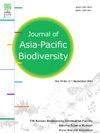The complete chloroplast genome sequence of Pseudolysimachion kiusianum var. diamantiacum (Plantaginaceae)
IF 0.7
Q4 BIODIVERSITY CONSERVATION
引用次数: 0
Abstract
The genus Pseudolysimachion, previously classified as a subgenus of Veronica (Plantaginaceae), was reclassified as an independent genus based on chromosomal and molecular studies. The genus comprises approximately 20 species distributed across Asia and Europe, 16 of which are found on the Korean Peninsula. Among these, Pseudolysimachion kiusianum var. diamantiacum (Nakai) T. Yamaz is an endemic species of the Korean Peninsula, notable for its unique morphological traits. Despite its horticultural potential and existing research on its cultivation, the genetic resources for Pseudolysimachion remain limited. In the present study, we sequenced the complete chloroplast genome sequence of P. kiusianum var. diamantiacum for the first time and conducted a phylogenetic analysis within the genus. The chloroplast genome of P. kiusianum var. diamantiacum is 152,249 bp long and features a large single-copy region (83,187 bp), small single-copy region (17,704 bp), and two inverted repeats (25,679 bp each). Phylogenetic analysis of 35 chloroplast genomes, one genome generated in this study and 34 obtained from the NCBI GenBank confirmed the monophyly of Plantaginaceae and positioned Pseudolysimachion within the Veroniceae tribe. The complete chloroplast genome sequence of P. kiusianum var. diamantiacum provided here can be utilized to develop species-specific markers through comparison with closely related species. Further studies should aim to clarify its phylogenetic position within Pseudolysimachion.
金车前草科金车前草叶绿体全基因组序列
原属车前草属(车前草科)的一个亚属,经染色体和分子研究被重新分类为一个独立属。该属大约有20种,分布在亚洲和欧洲,其中16种分布在朝鲜半岛。其中,Pseudolysimachion kiusianum var. diamantiacum (Nakai) T. Yamaz是朝鲜半岛特有种,以其独特的形态特征而闻名。尽管其具有潜在的园艺潜力和栽培研究,但其遗传资源仍然有限。在本研究中,我们首次测定了金猴金猴(P. kiusianum var. diamantiacum)的叶绿体全基因组序列,并对该属植物进行了系统发育分析。桃金猴(p.k usianum var. diamantiacum)叶绿体基因组长152,249 bp,具有大单拷贝区(83,187 bp)、小单拷贝区(17,704 bp)和两个反向重复(各25,679 bp)。对35个叶绿体基因组进行系统发育分析,其中本研究获得的1个基因组和NCBI GenBank中获得的34个基因组证实了车前草科植物的单系性,并将假蓼属植物定位于车前草科。本文所提供的桃金猴全叶绿体基因组序列可用于与近缘种进行比较,开发种特异性标记。进一步的研究应旨在明确其在假多毛目中的系统发育位置。
本文章由计算机程序翻译,如有差异,请以英文原文为准。
求助全文
约1分钟内获得全文
求助全文
来源期刊

Journal of Asia-Pacific Biodiversity
Agricultural and Biological Sciences-Insect Science
CiteScore
1.70
自引率
12.50%
发文量
94
审稿时长
27 days
期刊介绍:
The Journal of Asia-Pacific Biodiversity (previous title was Journal of Korean Nature) is an official journal of National Science Museum of Korea (NSMK) and Korea National Arboretum (KNA). The scope of journal is wide and multidisciplinary that publishes original research papers, review articles, as well as conceptual, technical and methodological papers on all aspects of biological diversity-its description, analysis and conservation, and its application by humankind. This wide and multidisciplinary journal aims to provide both scientists and practitioners in conservation theory, policy and management with comprehensive and applicable information. However, papers should not be submitted that deal with microorganisms, except in invited paper. Articles that are focused on the social and economical aspects of biodiversity will be normally not accepted.
 求助内容:
求助内容: 应助结果提醒方式:
应助结果提醒方式:


